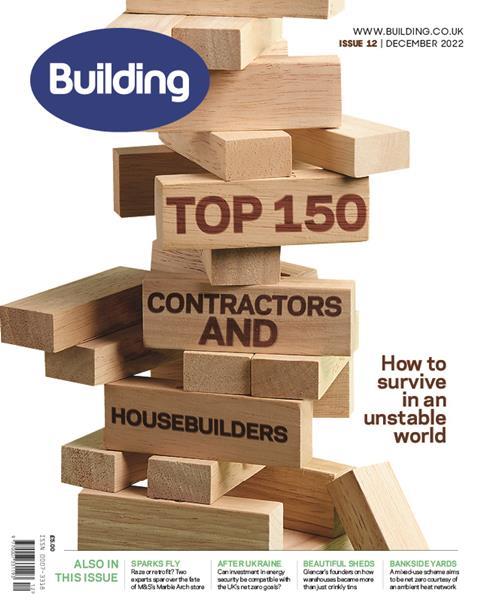Contractors and housebuilders in this week’s league tables have shown resilience through tough times – can they do it all over again next year?
We end this roller-coaster of a year on a high with a positive set of results coming from our top 150 contractors and housebuilders league tables.

The headline figure is that total turnover for the firms in the rankings increased by an average 18%, and much of the growth appears to have been driven by the housebuilders. Our analysis shows that the UK’s 50 biggest housebuilders in the tables turned over £38.6bn, an increase from £31.8bn the previous year. What is more, they created £5.6bn of operating profit at an 11.7% margin – up from 7.8%.
Margins like this are something most contractors can only dream of. Still, the contracting firms we spoke to for this year’s top 150 were largely stoical about the current and future market conditions. Working through recent successive crises has demanded resilience, and so the prospect of a long recession, as forecast by the CBI and the Bank of England, is met – in some cases – with a shrug and a sense that firms at least have had time to prepare and plan.
Returning to our league tables, taken from the latest available company results, the story that emerges is inevitably backward-looking. Companies’ year-end dates vary but most cover the 2021 calendar year, while some dip into the first half of this year. This means the positive numbers are mostly down to the post-lockdown recovery – in short, 2021 was bound to look better compared with 2020 which was marred by enforced shutdowns.
And then this year happened, with its sagas, dramas and general sense of permanent chaos
The period had its challenges nonetheless. It seems a long time ago now but growth in 2021 was hobbled to a large extent by a scarcity of materials, workers and in the case of housebuilders, land. Another inhibitor in the world of housing has been the ongoing delays to schemes blamed on the planning system.
And then this year happened, overshadowing all of that with its sagas, dramas and general sense of permanent chaos. Just some of the lowlights of 2022 included: Russia’s invasion of Ukraine in February triggering an energy crisis in Europe; months of political instability in the UK as Boris Johnson tried and failed to survive the party-gate fallout; Liz Truss’s reckless 44 days in office featuring the notorious mini-Budget with its £45bn of unfunded tax cuts that slashed the value of the pound and caused a run on gilts; a screeching about-turn within the Tory party, ushering in first Jeremy Hunt as chancellor and then Rishi Sunak as PM; November’s sober autumn statement raising £55bn in tax rises and spending cuts; and finally predictions of the longest recession on record that lasts until 2024 and shrinks the economy by 2%.
There was much else besides, but as a whistle-stop tour of the year it just about sums it up. For the people trying to run businesses through it all, there has been a lot to contend with.
Housebuilders have certainly felt the impact. The Office for Budget Responsibility is estimating completions will drop by one quarter over four years as house prices fall 9.2%. Help to Buy has run its course, sales have slumped and listed builders have seen their share values nearly halved.
And yet we found grounds for optimism, with many feeling that mortgage rates have peaked and taking heart from strong employment figures and from rental prices that are holding up. And unlike in the 2008 financial crisis, housebuilders are not burdened by debt and are generally in a much healthier businesses.
Contractors may not be in such good shape. On the plus side, the autumn statement did seem to create more stable market conditions and, after a few nail-biting weeks, the recommitment to big infrastructure schemes such as Sizewell C and HS2 felt significant. It was a moment when the industry needed to hear that the chancellor is backing investment in capital projects because he believes they drive economic growth.
We have also seen in the ONS figures out this week that construction output rose 0.8% in October; it was the fourth successive month of growth, and the rate is more impressive if you consider that construction output saw an increase of 1.1% in the three months to October.
On the less positive side, the economy as a whole shrank by 0.3% for the same three months, weighed down by inflation at 11.1% and by the cost-of-living crisis hitting consumer demand, to say nothing of the drag on our economy courtesy of Brexit. Construction bosses know the industry’s fate is closely tied to the rest of the economy, which explains why market confidence is at its lowest point since May 2020, when we were in the grip of the pandemic, according to the latest S&P Global/CIPS UK Construction PMI report.
On the face of it pipelines of work look good, but when pushed many firms admit they are not sure they believe all the jobs supposedly lined up for the end of next year and beyond will come through. And so, with news of some redundancies already starting to filter through, most employers are holding off expanding their teams.
The twists and turns of the year just gone demonstrate the futility of predictions, so best not to make any. But perhaps what we can say is that whatever 2023 brings, these league tables reveal the strength of the sector’s top performers – and in all likelihood companies will need all the strength they have to deal with what is coming next.
Chloe McCulloch is ºÚ¶´ÉçÇø’s editor
ºÚ¶´ÉçÇø’s Top 150 Contractors and Housebuilders

Our coverage this week and includes:
>> Sortable tables allowing you to track and compare turnover and pre-tax profit
>> Data showing firms’ extent of activity in contracting, housing, property and services
>>In-depth analysis of the latest trends in contracting and housebuilding



























No comments yet